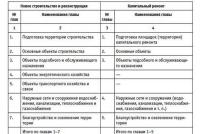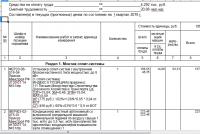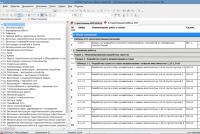1c accounting reconciliation act. Accounting info. Autocomplete remaining tabs
The act of reconciliation of mutual settlements is called a special document in which mutual settlements for a certain period of time are indicated between counterparties. In a software product called "1C 8.3", the reconciliation act can be carried out literally in one minute. And, which is very important, this work does not require routine collection of information. And now, giving an example, let's see how this can be done.
In the program "1C Accounting 3.0" we make a new reconciliation act
For example, we will carry out a reconciliation for 2014 between our buyer "Confetprom" and the enterprise "Servicelog".
In the interface, the log of reconciliation acts is located on the tabs called "Sales" and "Purchases":
In order to form a new reconciliation in the journal, you need to press the button called "Create". After that, a new form will open. required document... Next, we fill in the main details:
The firm is our legal entity;
Counterparty - our client (buyer);
Agreement - if necessary, reconciliation by specific agreement (requisite is not required);
Period - for which dates the reconciliation is carried out;
Reconciliation agreed - flag, makes it impossible to change the document.
After filling in the main fields, look at the tab named "Settlement Accounts", which by default is filled with the required values.
However, if the company uses some other accounting accounts, be sure to add them to the list:
The last tab with settings called "Advanced" looks like this:
The following parameters are specified here:
Representatives of the counterparty and the company - persons whose signatures will be indicated on the printed form of the reconciliation report;
Split according to the concluded agreements (contracts) - the flag, in printed form "1C" makes it possible to see the breakdown of mutual settlements in the context of contracts;
Display the full names of each of the documents - if the checkbox is checked, then the name in the reconciliation report will look like "Receipt to current account". If this is not established, then simply "Payment".
How to fill out an act in 1C?
And now we turn to filling out information on mutual settlements. For this purpose, the software product has two tabs - "According to the counterparty" and "According to the organization" (our accounting information).
To fill in the information of our company, it is possible to use the button with the name "Fill in according to accounting data":
According to the agreement with the counterparty, it is possible to fill in the tab called "According to the counterparty" from our information using a similar button.
After filling in the necessary data, using the "Write" button, you need to write down the document. Now this document can be printed:
After reconciliation of the reconciliation act in your counterparty, you need to correctly check the box with the name "Reconciliation approved". After its installation, it will be impossible to correct the document.
Draw up an act of reconciliation for a certain period in the program 1C 8.3 Accounting
The act of reconciliation of mutual settlements is a special document, which indicates the status of mutual settlements between counterparties for a certain time period. In 1C 8.3, an act of reconciliation can be done in literally 1 minute and this does not require routine collection of information. Let's look at an example of how to do this.
We make a new reconciliation act in 1C Accounting 3.0
For example, let's make a reconciliation for 14 years between our organization "Servicelog" and our buyer "Konfetprom".
In the interface, the log of reconciliation acts is located on the Purchases and Sales tabs:
To create a new reconciliation, click the "Create" button in the journal. A new document form will open. Let's fill in the main details:

- Organization is our legal entity
- Counterparty - buyer or supplier
- Contract - if reconciliation is required for a specific contract (not a mandatory requisite)
- Period - for which dates the reconciliation is performed
- Reconciliation approved - flag prohibiting document editing
After filling in the main fields, pay attention to the tab "Accounting accounts", by default it is filled with the necessary values. However, if the organization uses any other accounting accounts, be sure to add them to the list:

The last tab with the settings is "Advanced":

Here you can specify such parameters as:
- Representatives of the organization and the counterparty - persons whose signatures will be indicated on the printed form of the reconciliation report
- Split by agreement - a flag that allows you to see a breakdown of mutual settlements in the context of agreements in 1C printed form
- Display the full names of documents - if the flag is set, the name in the reconciliation act will have the form "Receipt to the current account", if not set simply "Payment"
We fill out the act in 1C
We proceed directly to filling in the data on mutual settlements. To do this, the program provides two tabs - "According to the organization" (our credentials) and "According to the counterparty".
To fill in the data of our organization - you can use the button "Fill in according to the data of accounting. accounting ":

Depending on the agreement with the counterparty, you can fill in the "By counterparty data" tab from our data using a similar button.
After all the data is filled in, you need to write down the document using the "Write" button. The document can now be printed:

After you have certified the reconciliation statement from your counterparty, correctly set the "Reconciliation approved" flag, which prohibits document corrections.
Based on materials: programmist1s.ru
- mutual form of information exchange between. Timely formation of the document allows you to identify errors in the accounting of both parties, as well as check the status of payment for the services provided or shipped goods.
The processing can be used by any person in the organization who has appropriate access to the workspace. Data output is carried out on the basis of primary operations entered into the database by responsible persons.
Where to find such a speaker
There are several ways to call into the work of processing the formation of a reconciliation act. According to the first algorithm, the operator (accountant) of the accounting program must follow the 1C menu in the "sales management", then the user is presented with a register of reconciliation statements already formed in the accounting system, which were registered and sent to the counterparty. The work can be carried out both in a ready-made document and a new one.
Depending on the version of the accounting program and the type of business entity, the reconciliation act may be in the form of a separate development in the "processing" section. Often there is no such report in the licensed package of an organization, and therefore it can be developed by a service organization for the specifics and needs of the enterprise. Processing is stored in the program folder of the system, called by menu items. If there are no reconciliation statements in the standard hierarchy, you can call it through the path of its location. Press "File", then "open" and refer to the place where the processing is located. Most often, the location of the file is network.
How to make a reconciliation act in 1C
There are many options here. It all depends on what tasks the performer faces. The practice of business entities usually implies group processing, that is, the creation of quarterly new documents for all contractors is set. Most often, the group formation is carried out by the chief accountant or support specialist.
The need to create a reconciliation statement is sometimes caused by a request from employees of the organization itself (repeated notification) or a request from a counterparty to create a document with certain parameters. For example, it can be the past year or five months of the current tax period... The user of the program sets the necessary parameters, such as the period, the parties to the transaction (there can be several names in his own organization, if it is a financial group and a consumer of services), an agreement (if a sample is required) and a settlement currency.
Versions 8.3 and 8.2
The main difference of the new version of the platform is the improved interface of the program. If you could “get” to the reconciliation act in 1C 8.2 through the “sale” menu item, then in 1C 8.3 the user calls this option through the field for settlements with counterparties.
After starting processing, similar tabular forms appear that must be filled out.
The act of reconciliation of mutual settlements in 1C 8.3 Accounting 3.0 s sample fillingshown in this video:
Version 7.7
For the correct work on the exchange of documents between business entities, a software component with operational accounting modules is required. Processing, unlike the updated versions, is distinguished by the simplicity of the form and the fact that only transactions from accounts 60 and 62, respectively, are included in the report.
For purposes management accounting such processing will not work.
UT 10.3
The version of the "1C: Trade Management" program has extended functionality. Reconciliation acts are called by appropriate processing, configured by the user before printing or automatically sent to counterparties through special modules. The appearance of the reports depends on which platform the management program is running on, 8.2, 8.3, and so on.
1C: Trade
In this version software to work with reconciliation statements, you need to know some of the module's features. The report is generated from processing, which is located in the ExtForms directory as standard. Processing can be called through the "Open" menu item. After opening the module for the first time, the path becomes available at the bottom of the command list.
If you correctly unpack the reconciliation report into the database directory, the processing call becomes available through the "Service" menu, then "Additional features". Before forming the user specifies the request in the fields: "company", "counterparty", "contract", "period".
How to call the reconciliation act
UT
 The simplicity and functionality of this program allows users to navigate quickly enough. In the window of the running program, you must click on the menu item "Additional reports and processing, then" Reconciliation of settlements ". Several custom settings and the form is ready for printing based on the actual data.
The simplicity and functionality of this program allows users to navigate quickly enough. In the window of the running program, you must click on the menu item "Additional reports and processing, then" Reconciliation of settlements ". Several custom settings and the form is ready for printing based on the actual data.
The reconciliation report 1C is a document containing information about the status of settlements between counterparties for a selected period and on a specific date. Making a reconciliation statement in the program is a simple operation, which will help you to master it with our tips. Introducing step by step instructionshow to make a reconciliation act in 1C 8.3.
How to make an act of reconciliation in 1C 8.3 Accounting
Where can I find the reconciliation report in 1C 8.3? Reconciliation of calculations is drawn up document in section Purchases - Settlements with counterparties - Acts of settlement reconciliation - Create button.
Let's consider how to form a reconciliation act in 1C according to this example.
Reconciliation period
The period and the counterparty with whom the reconciliation is carried out are filled in in the header of the document Statement of reconciliation of settlements with counterparties ... Let's take a closer look:
- From - date of formation of the act of reconciliation with the counterparty;
- Counterparty - a buyer, supplier or other counterparty with whom the reconciliation of settlements is carried out;
- Contract - the document used for settlements with the counterparty.
- Period - the period of reconciliation of mutual settlements. It is during this period that the data in the tabular section will be displayed.
You can also reconcile settlements with the counterparty and stand-alone units in one act, this requires:
- select the head organization in the field Counterparty ;
- check the box With separate divisions .
Settlement accounts for which reconciliation is carried out
After filling in the counterparty, you must also indicate the accounting accounts for which settlements with the counterparty will be analyzed. This must be done in the tab Settlement accounts by checking the necessary boxes.

If you need to add another account that is not reflected in the default tabular section, then you must use the button Add to ... In this case, one of the subkontos in the added account must be Contractors and Contracts if the reconciliation is also under a certain agreement. Otherwise, the data on this account will not be automatically filled in.
Reconciliation of settlements with the counterparty
After installation required settings we fill out calculations with the counterparty on the tabs According to the organization , According to the counterparty .
This can be done in several ways:
- manually by button Add to ;
- automatically fill in according to data in the database by button Fill in .
In this case, you can fill in immediately:
- for our organization and counterparty;
- or only for our organization.

If you choose By our organization and counterparty , then both tabs will be filled ( According to the organization and According to the counterparty ).

If you choose Only by our organization then the tab According to the counterparty must be filled in manually or by button Fill in , but already on the tab According to the counterparty .

Let's take a closer look at filling out the columns on the tabs According to the organization and According to the counterparty :
- date - the date of the business transaction (receipt, sale, payment, etc.). Filled in with date primary document.
- Document - link to the primary document in the database.
- Representation - a brief description of the business transaction, in brackets - date, number of the primary document (incoming or outgoing data of the primary document). It is these data that fall into the printed form of the document. Reconciliation statement ... Read more about displaying the full name of documents in printed form Reconciliation report.
- Debit - the amount shown in debit;
- Credit - the amount reflected in the loan.
The document footer displays:
- Balance at the beginning - final settlements with the counterparty on the starting date specified in the field Period ... In our example Receipt from 01/10/2018 in the amount of 1,416,000 rubles... was not included in the reconciliation period, therefore the unpaid amount is reflected in this field.
- End balance - final settlements as of the end date specified in the field Period ... In our example, an advance payment is made against future deliveries in the amount of 295,000 rubles; since it is not closed on 02/28/2018, then it is displayed in this field.
- Discrepancy with counterparty (Discrepancy with organization) - must be equal to "0". If there is an amount in this field, then some data is missing in the database. Perhaps the payment was not posted or you forgot to enter the receipt (sale) document. What to do if mistakes were made in settlements with the counterparty and the reconciliation statement turned out to be incorrect?
After filling in and checking the data Act of reconciliation it is necessary to agree or transfer to the counterparty for approval:
- in paper form, for this you need to print it. More details on how to print a reconciliation statement in 1C?
- in in electronic format, for this you can:
- send directly from 1C by button More - Email... More details on how to set up email in 1C;
- save the printable to your computer and send it via external email.
How to print a reconciliation statement in 1C
Click the button Seal - Reconciliation Act document Statement of reconciliation of settlements with counterparties ... The printed form is divided into two parts (with data on our organization and the counterparty) and will include the amount of transactions, turnovers and final balances.
How to display the full name of a document in printed form Reconciliation report
Document titles in printed form can be displayed in two forms:
- short name - "Payment (258 from 01.02.2018)";

- full name - "Write-off from the current account (258 from 01.02.2018)".

To display the full name, check the box Display full document titles in the tab Additionally .

How to display invoices in the reconciliation act

To display invoices in the form Reconciliation statement Display invoices in the tab Additionally .

How to indicate contracts in the reconciliation act

To withdraw contracts in the form Reconciliation statement must be checked Break down by contracts in the tab Additionally .

How to indicate in the reconciliation act the responsible persons signing it
Let's consider how to fill out the printed form of the reconciliation act so that the responsible persons of our organization and the counterparty signing the reconciliation act are automatically indicated in it.
In printed form Reconciliation statement Name and position of representatives of the parties are filled in according to the tab data Additionally in section Representatives of the parties .

This data is automatically filled in when you create a document, if necessary, you can change it manually.
In printed form Reconciliation statement We will see data on the representative of the counterparty LLC KLERMONT in two places: in the text of the act and at the bottom of the act - where the counterparty's stamp is affixed.

If Counterparty representative in the tab Additionally is not specified, the data on it will not be included in the printed form.

In order not to redo the document, you can enter the full name of the counterparty's representative in the empty field by hand.
How to display the facsimile signature and seal of the organization in the reconciliation act
To display the facsimile signature of the head and seal the organization, you must select the checkbox Signature and stamp on the printable command line Reconciliation statement .

How to correct mistakes and agree on a reconciliation act in 1C
There are discrepancies with the counterparty
If other data are reflected in the accounting of the counterparty that do not coincide with those entered in our act, then you will have to find the reason. It is possible that a mistake was made in the accounting of our organization: in the amount, date, etc. It is necessary to find it and correct it. And after that, again draw up a reconciliation act in 1C Accounting and transfer it to the counterparty for approval.
Reconciliation agreed
If the counterparty approved the amounts entered in the reconciliation act and signed it without discrepancies, then the document must be checked Reconciliation agreed .

After installing it, the document Statement of reconciliation of settlements with the counterparty closes from editing and no data can already be corrected in it, while this checkbox is checked.
Where can I find the reconciliation report in 1C 8.3? Reconciliation of calculations is drawn up document in section Purchases - Settlements with counterparties - Acts of settlement reconciliation - Create button.
The organization has entered into a contract for the supply of kitchen furniture with KLERMONT LLC.
On February 22, the organization paid for the delivery of furniture dated February 15 and made an advance payment for the next delivery in the amount of 295,000 rubles.
Let's consider how to form a reconciliation act in 1C according to this example.
Reconciliation period
The period and the counterparty with whom the reconciliation is carried out are filled in in the header of the document Statement of reconciliation of settlements with counterparties ... Let's take a closer look:
- From - date of formation of the act of reconciliation with the counterparty;
- Counterparty - a buyer, supplier or other counterparty with whom the reconciliation of settlements is carried out;
- Contract - the document used for settlements with the counterparty.
Contract is indicated only if it is necessary to reconcile the calculations with the counterparty under a specific agreement. If the field is not filled in, then reconciliation is carried out for all contracts of the counterparty.
- Period - the period of reconciliation of mutual settlements. It is during this period that the data in the tabular section will be displayed.
You can also reconcile settlements with the counterparty and its separate subdivisions in one act, for this you need to:
- select the head organization in the field Counterparty ;
- check the box With separate divisions .
Settlement accounts for which reconciliation is carried out
After filling in the counterparty, you must also indicate the accounting accounts for which settlements with the counterparty will be analyzed. This must be done in the tab Settlement accounts by checking the necessary boxes.

If you need to add another account that is not reflected in the default tabular section, then you must use the button Add to ... In this case, one of the subkontos in the added account must be Contractors and Contracts if the reconciliation is also under a certain agreement. Otherwise, the data on this account will not be automatically filled in.
Reconciliation of settlements with the counterparty
After setting the necessary settings, we fill in the calculations with the counterparty on the tabs According to the organization , According to the counterparty .
This can be done in several ways:
- manually by button Add to ;
- automatically fill in according to data in the database by button Fill in .
In this case, you can fill in immediately:
- for our organization and counterparty;
- or only for our organization.

If you choose By our organization and counterparty , then both tabs will be filled ( According to the organization and According to the counterparty ).

If you choose Only by our organization then the tab According to the counterparty must be filled in manually or by button Fill in , but already on the tab According to the counterparty .

Let's take a closer look at filling out the columns on the tabs According to the organization and According to the counterparty :
- date - the date of the business transaction (receipt, sale, payment, etc.). Filled in with the date of the original document.
- Document - link to the primary document in the database.
- Representation - a brief description of the business transaction, in brackets - date, number of the primary document (incoming or outgoing data of the primary document). It is these data that fall into the printed form of the document. Reconciliation statement ... More details.
- Debit - the amount shown in debit;
- Credit - the amount reflected in the loan.
The document footer displays:
- Balance at the beginning - final settlements with the counterparty on the starting date specified in the field Period ... In our example Receipt from 01/10/2018 in the amount of 1,416,000 rubles... was not included in the reconciliation period, therefore the unpaid amount is reflected in this field.
- End balance - final settlements as of the end date specified in the field Period ... In our example, an advance payment is made against future deliveries in the amount of 295,000 rubles; since it is not closed on 02/28/2018, then it is displayed in this field.
- Discrepancy with counterparty (Discrepancy with organization) - must be equal to "0". If there is an amount in this field, then some data is missing in the database. Perhaps the payment was not posted or you forgot to enter the receipt (sale) document.
After filling in and checking the data Act of reconciliation it is necessary or transferred to the counterparty for approval:
- in paper form, for this you need to print it. More details
- in electronic form, for this you can:
- send directly from 1C by button More - Email... More details;
- save the printable to your computer and send it via external email.
How to print a reconciliation statement in 1C
Click the button Seal - Reconciliation Act document Statement of reconciliation of settlements with counterparties ... The printed form is divided into two parts (with data on our organization and the counterparty) and will include the amount of transactions, turnovers and final balances.
How to display the full name of a document in printed form Reconciliation report
Document titles in printed form can be displayed in two forms:
- short name - "Payment (258 from 01.02.2018)";

- full name - "Write-off from the current account (258 from 01.02.2018)".

To display the full name, check the box Display full document titles in the tab Additionally .

How to display invoices in the reconciliation act

To display invoices in the form Reconciliation statement Display invoices in the tab Additionally .

How to indicate contracts in the reconciliation act

To withdraw contracts in the form Reconciliation statement must be checked Break down by contracts in the tab Additionally .

If the reconciliation is carried out with the head counterparty (HO) and its separate divisions (OP), then the checkbox Break down by contracts you need to install it carefully: there may be a doubling of revolutions, if there was an adjustment of mutual settlements (Payment from the GO, delivery from the OP or vice versa)
How to indicate in the reconciliation act the responsible persons signing it
Let's consider how to fill out the printed form of the reconciliation act so that the responsible persons of our organization and the counterparty signing the reconciliation act are automatically indicated in it.
In the 1C program, a reconciliation act has been drawn up between our Organization and KLERMONT LLC. It is necessary to indicate in its printed form the full names of the managers signing the reconciliation statement:
- Druzhnikov G. P. - from the side of the Organization;
- Vasiliev S.S. - from the side of KLERMONT LLC.
In printed form Reconciliation statement Name and position of representatives of the parties are filled in according to the tab data Additionally in section Representatives of the parties .

This data is automatically filled in when you create a document, if necessary, you can change it manually.
If you are a commercial subscriber of the BukhExpert8 system - Rubricator 1C Accounting, then you can study in more detail about filling in the responsible persons in the documents:
In printed form Reconciliation statement We will see data on the representative of the counterparty LLC KLERMONT in two places: in the text of the act and at the bottom of the act - where the counterparty's stamp is affixed.

If Counterparty representative in the tab Additionally is not specified, the data on it will not be included in the printed form.

In order not to redo the document, you can enter the full name of the counterparty's representative in the empty field by hand.
How to display the facsimile signature and seal of the organization in the reconciliation act
To display the facsimile signature of the head and seal the organization, you must select the checkbox Signature and stamp on the printable command line Reconciliation statement .

If you are a commercial subscriber of the BukhExpert8 system - Rubricator 1C Accounting, then read additional material






